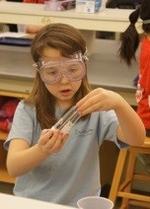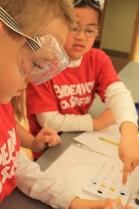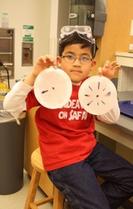The case of the missing bunny — “Maddy”
Our day begins with this story:
Maddy, the Endeavor Charter School second-grade class’s rabbit is missing. The cage was found open. Near the cage was a clear, colorless liquid in a flask. On the floor was a white powder. A torn piece of fabric with dark red stains hung on the cage door. Attached to the cage was a note written in black ink by the culprit claiming to have taken Maddy. Who could have carried out this foul deed? The evidence was gathered and taken to the lab for analysis. At the lab, chemists trained in chemical forensics determined the chemical identity of each bit of evidence using a variety of chemical techniques. The probable perpetrator of the crime was identified based on the results of the chemical analyses and descriptions of the possible suspects.
I am certain that many of you have had your students perform some version of chemical forensics, either your own or from a commercial kit. For those who have not, it is a great way to teach chemical concepts, such as viscosity, reactivity, precipitation, chemiluminescence, separation (chromatography) and dyes.
Over the years our chemical forensic activity has evolved into what it is today. We begin by using a PowerPoint® presentation1 to set the scene, showing the rabbit in the cage followed by the empty cage with the evidence. Following this, we show the likely suspects (staff at the school) with a photo and a motive for why he or she would take the rabbit. For example, one suspect is a real fashonista who has always wanted a rabbit fur coat. Background sheets on all suspects with information such as blood-type, clothing, the type of pen they use, etc., are provided near the end of the analysis.

Overview of activity at each station
The collected evidence are a liquid, a white powder, a red-stained cloth, a blood sample (simulated blood, not real blood) and a handwritten ransom note. The following are brief descriptions of the tasks at each of the six lab stations. Student instructions are available from the authors on request.1
- Viscosity: ID of the liquid
Liquid is found at the scene of the crime; students are asked to compare the flow rate of this liquid with sample tubes of water, glycerin, mineral oil and corn syrup.
- Reactivity: ID of the solid
Using vinegar, bromothymol blue and iodine, the reactivity of the unknown solid is compared to that of cornstarch, baking soda and Fruit Fresh®. (Ball® Fruit-Fresh® has dextrose, ascorbic acid, citric acid and silicon dioxide. It is used to prevent fresh fruit from browning.)
- Chemiluminescence: ID the presence of blood
Spray a luminol solution on the red-stained fabric in a darkened room. There will be a blue glow where iron is present indicating the presence of blood.
Luminol mixture: 0.1 g luminol dissolved in 20 mL of 10% NaOH, diluted to 200 mL with H2O. Then 20 mL of 6% H2O2 is added. Add this mixture to a spray bottle. Note the red stain is not real blood but a solution of K3[Fe(CN)6] dribbled on the cloth.



-
Precipitation: ID the blood type
-
Simulated blood testing kits are available from Educational Innovations. The formation of a precipitate indicates a match. The simulated Blood Testing kit is available at Educational Innovations for US$60. This kit comes complete for 60 students.
- Paper chromatography: ID of ink pen used for the note
Chromatograms are made from different brands of water- soluble black ink pens found on the suspects and compared to the ink in the note. Chromatograms are made with filter paper and water. Eight different ink pens are available from Flinn Scentific.
- Fabric dying: ID of the fabric found at the crime scene
Students dye an unknown sample of crime scene fabric and compare it with a multi-fabric test strip identification key. This activity takes the most time to complete. While students wait, they can begin the process of identifying the likely perpetrator.
The Fabric Identification Kit is available at Educational Innovations for approximately US$44. It has enough material to make 60 unknown fabric samples.
Example of a lab station procedure
We introduce the concept of viscosity, followed by a demonstration that helps the kids understand the concept. Three large glass tubes with different liquids (water, glycerin, mineral oil and corn syrup) are simultaneously turned over. Students can observe the air bubbles rise. Following the demonstration the kids are given four known liquids in which they are to determine the order of viscosities. Lastly, students are given a vial of the evidence found at the crime scene. Their goal is to figure out the identity of the liquid without any directions. The staff guide the kids without telling them exactly what to do. When everyone has completed the activity, students are brought together and asked the identity of the liquid. Students are asked to explain their reasoning. This process is repeated for each bit of evidence.
Overall impressions of CSI event
This past year second graders came to our campus lab to perform the CSI activities. It was easy for us to keep the setup for all the visiting classes. This arrangement gave students the opportunity to visit a college campus and work with college students in a lab. The entire set of activities takes about two hours and it was amazing to see second graders engaged the entire time. If set up properly, it is easy to change the perpetrator by simply changing the evidence corresponding to one of the suspects. Recently, we have had success with fourth and fifth grade girls as well as teens. We had assumed these two groups, especially the teens, would be bored. However, both groups were very engaged in the activities and seemed to enjoy “solving the crime”.
Natalie Williams has participated as a presenter for the fourth and fifth grade girls and at the “Teen Forensics Night at the Museum”. The following are her thoughts about working with these two groups as they carried out the analyses of the evidence to identify the likely perpetrator of the crime.
“The CSI event is a unique set of chemistry activities, bringing together many chemical concepts under one exciting theme: forensics. Forensics is a topic that all age groups find interesting.
I had the pleasure of leading a group of elementary girls through the activities, as well as teenagers. The activities caught the students’ attention from the get-go. This student engagement increased throughout because students felt a sense of duty to catch the culprit through step-by-step elimination of the suspects.Of the six activities, the participants seemed to enjoy the ones that provided great visualizations. The chemiluminescence activity generated the most ‘oohs’ and ‘ahhs’. Even seemingly less exciting concepts, such as viscosity turned into a fun topic. The word “precipitate” was exciting because it dealt with blood-typing. The students found this fascinating as they realized their own blood type could be determined by a chemical reaction.
Students left with souvenirs, which was another positive aspect of this event. The ink chromatograms look like tie-dyed pieces of art. The fabric identification test produced a rainbow strip of fabrics. These fun pieces of artwork serve as a reminder of all the chemistry learned during the CSI event.
Given how the elementary girls didn’t want to leave, and that the teens left with a more excited attitude about forensics, the events were successful. The practical and hands-on nature of the analysis made learning chemical concepts engaging and fun. I look forward to participating as a leader in the next CSI event.”
Note
- Describing the procedures for each activity performed in this chemistry forensics CSI lab would require more space than Chem13 News can print in one issue. Those of you who desire more information, can do so by contacting me at Duke University or Chem 13 News by email. When you contact us, we can provide the PowerPoint Crime Presentation, six suspect information sheets and student instructions for each station.
*Natalie Williams is a senior at Duke University majoring in neuroscience with a minor in chemistry. She plans to pursue a career in medicine.
**Kenneth Lyle, a lecturing-fellow in the Department of Chemistry at Duke University NC. Powell Family Trust, the Duke-Durham Neighborhood Partnership, and Biogen Idec - Research Triangle Park, fund the Duke Chemistry Outreach Program.







